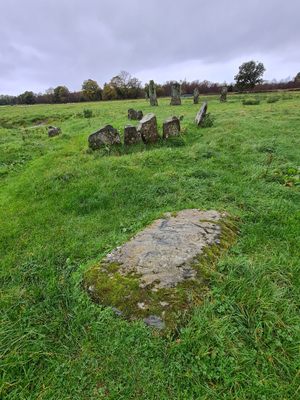About
Ballymeanoch, which means "the middle settlement" in Scottish Gaelic, is a complex selection of Neolithic structures located in Kilmartin Glen, made up of standing stones, a henge and cairns. The standing stones are thought to be the oldest structures at the site, estimated to have been built more than 4,000 years ago.
The Ballymeanoch complex features a group of standing stones arranged in two roughly parallel rows. The tallest stone stands four meters high and is in the row of four stones. The two middle stones are heavily carved with cup and ring marks, some also with "gutter" marks, where a line is carved between the cup and the ring. Don't be disheartened if you don't spot them immediately, you need to get the light to hit them just right.
The two stones on the other side are smaller and were once joined by a third stone pierced through with a hole. The third stone fell in the 19th century and now lies near the remains of the kerb cairn. It is believed that the six remaining standing stones (and their fallen comrade) were a part of a much larger parallel row of standing stones, similar to the Avenue at Avebury.
To the northeast of the standing stones sits is a kerb-cairn made up of around 10 slabs set upright in a rough circle, with a mound of grassed-over cobblestones in the centre. There’s little evidence to say exactly how many stones would have originally stood at the cairn or whether it is complete as it is now. Archaeologists estimate that the kerb-cairn was built between 1400 and 1200 B.C.
Within a small distance of the standing stones to the southwest are the remains of a henge monument, now ploughed almost flat and very hard to identify unless you know what you are looking for. There were two cist burials within the henge.
Related Tags
Know Before You Go
Park in the Dunchraigraig Cairn parking area on the A819 and walk across the road for the cairn. From there, simply head south across the fields following the fence lined path until you come out in to the field where the standing stones are clearly visible.
Community Contributors
Added By
Published
November 18, 2021
























